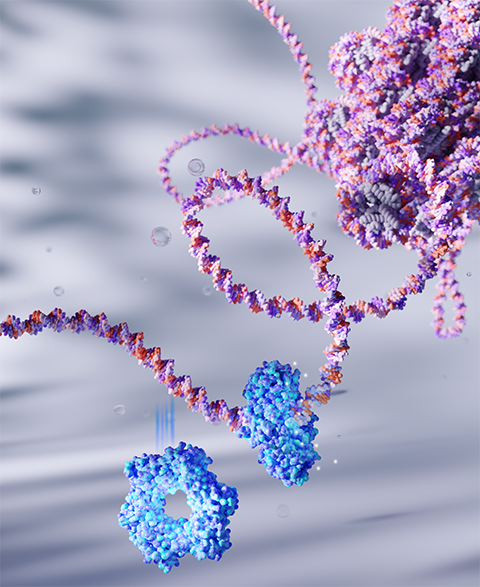Biochemists identify cause of rare disease
A recent study published in the Journal of Biological Chemistry led to the discovery of the genetic origin of a rare disorder in children.
The condition is known as PARD, which is short for PCNA-Associated DNA Repair Disorder, and it was only identified in 2014. The disease causes intellectual disabilities, accelerated aging, extreme photosensitivity, deafness and more. The mutation identified in this study is only the second to ever be described.
PCNA stands for proliferating cell nuclear antigen, a protein that slides on DNA and promotes DNA repair and replication. The team of researchers led by Brian Kelch, an associate professor of biochemistry and biotechnology at the University of Massachusetts Chan Medical School, determined that PARD may be caused by a mutation in PCNA that causes it to be unstable at high temperatures.

The team began investigating this protein and its role in PARD after receiving a phone call from Alexander Jorge, an associate professor of medicine at the University of São Paulo, Brazil, who diagnosed and sequenced the genomes of three unrelated patients with PARD in his clinic. The patients all had an identical PCNA mutation, known as C148S, but it was unclear why this mutation caused such severe disease.
“PCNA performs so many different roles in the cell during DNA replication, DNA repair, cell cycle and chromatin assembly,” Joe Magrino, a graduate student at UMass and lead author on the study, said. “PCNA is called the ‘maestro of DNA replication’ because it plays a central role in coordinating the copying of DNA with other aspects of normal cellular behavior, such as repairing damaged DNA and determining when a cell divides.”
Kelch likened the shape of PCNA to a doughnut and said it clamps onto DNA to perform its normal duties inside the cell.

“The fact that PCNA is shaped like a ring or a doughnut is absolutely central to its function, because its job is essentially tethering other things to DNA,” Kelch said. “So, its ability to stay on DNA is critically important.”
To figure out the mutation’s impact, the team solved its structure and performed a variety of biochemistry experiments to see how well PCNA bound to DNA in different situations.
“We showed that the new variant discovered in Brazil disrupts the stability of the protein, making it less stable,” Kelch said. “This appears to make it fall off DNA more easily.”
Magrino added: “Our data also suggest that the amount of time PCNA spends on DNA is in a Goldilocks zone. The time can’t be too long or too short and needs to be just right to perform its function.”
In addition, the team observed that the PCNA mutant was extremely sensitive to high temperatures and becomes unstable around normal human body temperature.
“The mutant PCNA functions like a normal protein at room temperature,” Magrino said. “But, if I heat it up to human body temperature, the mutants have profound stability defects that cause them to fail as functional proteins.”
Even though the team studies molecular biochemistry, these findings had an immediate impact on the PARD patients’ care.
“Because we found that PCNA proteins that have the PARD mutations are sensitive to heat, our physician colleagues are now very cognizant of body temperature of PARD patients and are proactively treating them when they run a fever,” Kelch said.
The team is currently working on designing new techniques to visualize the mutant PCNA bound to DNA. These efforts have proved difficult because they are the first to attempt this goal. Kelch said these experiments and others could help them predict which other mutations in PCNA might lead to PARD.
In addition to benefiting patients with PARD and PARD-like diseases, Kelch and Magrino’s work might someday have implications for cancer treatment because it coordinates the action of numerous proteins that are commonly mutated in cancer patients.
“We know that there's another protein complex, called ATAD5, that works to remove PCNA from DNA,” Kelch said. “I think that PCNA is important for all sorts of diseases, including cancer. So, this is going to be a really important avenue of investigation in the immediate future.”
Enjoy reading ASBMB Today?
Become a member to receive the print edition four times a year and the digital edition monthly.
Learn moreGet the latest from ASBMB Today
Enter your email address, and we’ll send you a weekly email with recent articles, interviews and more.
Latest in Science
Science highlights or most popular articles

Building the blueprint to block HIV
Wesley Sundquist will present his work on the HIV capsid and revolutionary drug, Lenacapavir, at the ASBMB Annual Meeting, March 7–10, in Maryland.

Gut microbes hijack cancer pathway in high-fat diets
Researchers at the Feinstein Institutes for Medical Research found that a high-fat diet increases ammonia-producing bacteria in the gut microbiome of mice, which in turn disrupts TGF-β signaling and promotes colorectal cancer.

Mapping fentanyl’s cellular footprint
Using a new imaging method, researchers at State University of New York at Buffalo traced fentanyl’s effects inside brain immune cells, revealing how the drug alters lipid droplets, pointing to new paths for addiction diagnostics.

Designing life’s building blocks with AI
Tanja Kortemme, a professor at the University of California, San Francisco, will discuss her research using computational biology to engineer proteins at the 2026 ASBMB Annual Meeting.

Cholesterol as a novel biomarker for Fragile X syndrome
Researchers in Quebec identified lower levels of a brain cholesterol metabolite, 24-hydroxycholesterol, in patients with fragile X syndrome, a finding that could provide a simple blood-based biomarker for understanding and managing the condition.

How lipid metabolism shapes sperm development
Researchers at Hokkaido University identify the enzyme behind a key lipid in sperm development. The findings reveal how seminolipids shape sperm formation and may inform future diagnostics and treatments for male infertility.

